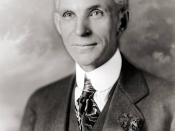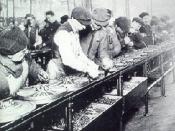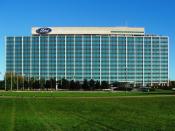Henry Ford
The Assembly Line
Most people credit Henry Ford with inventing the automobile. The fact is he didn't -- such a complex machine is the result of a combination of technologies developed by many people over time. He did, however, invent the assembly line, which revolutionized the way we make cars, and how much they cost.
In 1908, Ford's company began selling his famous Model T for $850 each. The Model T was inexpensive for its day, and proved to be sturdy, reliable and easy to operate. It quickly became very popular; and soon Ford found he was unable to meet the enormous demand for his cars.
Ford's solution was to invent a moving industrial production line. By installing a moving belt in his factory, employees would be able to build cars one piece at a time, instead of one car at a time. This principle, called "division of labour," allowed workers to focus on doing one thing very well, rather than being responsible for a number of tasks.
Ford found his new system produced cars quickly and efficiently; so efficiently that it considerably lowered the cost of assembling the cars. He decided to pass this savings along to his customers, and in 1915 dropped the price of the Model T to $290. That year, he sold 1 million cars.
In 1891, Ford became an engineer with the Edison Illuminating Company in Detroit. This event signified a conscious decision on Ford's part to dedicate his life to industrial pursuits. His promotion to Chief Engineer in 1893 gave him enough time and money to devote attention to his personal experiments on internal combustion engines.
These experiments culminated in 1896 with the completion of his own self-propelled vehicle-the Quadricycle. The Quadricycle had four wire wheels that looked like heavy bicycle wheels,



V.Good
Very comprehensive and well written. Useof points avoids info dump/overload
3 out of 3 people found this comment useful.